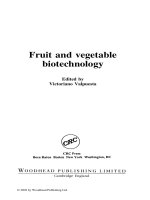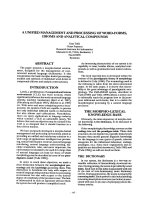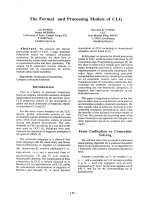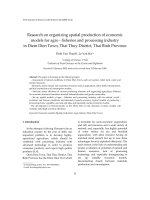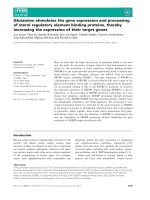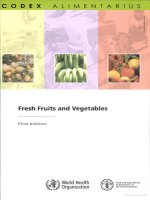FRUIT AND VEGETABLE PRESERVATION AND PROCESSING
Bạn đang xem bản rút gọn của tài liệu. Xem và tải ngay bản đầy đủ của tài liệu tại đây (1.47 MB, 36 trang )
MINISTRY OF EDUCATION AND TRAINING
NONG LAM UNIVERSITY – HO CHI MINH CITY
FACULTY: CHEMICAL ENGINEERING AND FOOD TECHNOLOGY
----
FRUIT AND VEGETABLE
PRESERVATION AND PROCESSING
MANGO
GROUP 3 - MEMBERS
Võ Nguyễn Thục Trinh
Bùi Thiên Lộc
Nguyễn Thu Hiền
Đỗ Hồng Ánh Mai
Đỗ Thị Yến Ly
Đỗ Thành Trung
January 2022 - Ho Chi Minh city
TABLE OF CONTENT
TABLE OF CONTENT ...................................................................................... 1
INTRODUCTION ............................................................................................... 2
CHARACTERISTIC OF MANGO..................................................................... 3
I. General sensorial and nutritional values of mango ...................................... 3
1. Sensorial Values ...................................................................................... 3
2. Flavor and Texture .................................................................................. 4
3. Nutritional Values ................................................................................... 6
II. Some popular types of mango in Vietnam ................................................. 8
1. Sensorial Values ...................................................................................... 8
2. Nutritional Values ................................................................................. 10
Mango production and geographic distribution ............................................ 11
EXPORT AND CONSUMPTION .................................................................... 16
I. Export ......................................................................................................... 16
II. Consumption ............................................................................................. 23
MANGO PRESERVATION AND PROBLEMS RELATED TO IT ............... 26
I. Preservation of mango fruits ...................................................................... 26
1. Post-harvest Storage Conditions of Mango ........................................... 26
2. Effect of Temperature on Storage Conditions of Mango ...................... 27
3. Effect of other factors on Storage Conditions of Mango ...................... 28
II. Problems ................................................................................................... 29
1. Physiological Disorders ......................................................................... 29
2. Pathological Disorders .......................................................................... 29
III. Control Strategies .................................................................................... 30
MANGO JUICE PROCESSING AND PROBLEMS RELATED TO IT ........ 31
CONCLUSION ................................................................................................. 34
REFERENCES .................................................................................................. 34
1
INTRODUCTION
Mango is regarded as the king of fruits. It thrives in tropical areas and has been
a human favorite for over 4000 years. Mango and mango juice are high in vitamins and
minerals that are necessary for human health. Mango is a highly sweet fruit, therefore
there is no need to add sugar to it, which makes it very good for health.
Mangoes are high in vitamin C, beta carotene, potassium, iron, and a variety of
other minerals that help the body fight illnesses and maintain overall health. The exotic
fruit, which is recognized for its wonderful and divine taste, is invigorating, and
nourishing and is best consumed throughout the summer months. Mangoes come in a
variety of flavors, from sweet to sour, and their juices are no exception.
In a list of the world's top mango producers, Vietnam is ranked 14th. Mangoes
have traditionally been grown in Vietnam's Central and Southern regions. Mangoes are
not commercially farmed in the north; however, well-known regions include the Mai
Son and Yen Chau districts in Son La province, Yen Minh, a rural district of Ha Giang
Province, and Lai Chau province, where winter temperatures are relatively high, and
humidity is low (which is considered very favorable for pollination and fertilization of
mangoes). Mangoes, on the other hand, are commonly cultivated as ornamental or shade
trees in household gardens and pagodas in many inland provinces in the North. In
southern Vietnam, Tien Giang, Dong Thap, Can Tho, Vinh Long, and Khanh Hoa are
the main production locations. Mangoes are farmed in the provinces of Đong Nai and
Ba Ria-Vung Tau to the east of Cochinchine.
In 2017, Vietnam had 92,746 hectares of mango production and produced
788,233 tons of mango, with the Mekong Delta accounting for 46.1 percent of the area
and 64.4 percent of the country's mango production, followed by the Southeast(Lap &
Chau, 2015).
The weather in the north of Vietnam is relatively cold in November and
December, with plenty of sunshine and little rain. Although these conditions should be
favorable for mango flowering, no commercial production is feasible because when the
mango flowers in January, cold northerly winds, cloudy skies, and drizzling rain occur,
resulting in poor fruit set, seedless small fruits, and a high incidence of diseases that
prevent fruit set and development.
Mango is a well-known fruit in Vietnam. The majority of Vietnamese mango
varieties are grown in the south and center of the country, in provinces such as Khanh
Hoa, Tien Giang, Hau Giang, and Dong Thap.
2
CHARACTERISTIC OF MANGO
Mango (Mangifera indica L.) is one of the most nutritious tropical fruits, native
to southern Asia and Eastern India. The mango fruit is fleshy, generally sweet in taste
and varies considerably in size, shape, color, flavor, and composition (FAO, 2002).
I. General sensorial and nutritional values of mango
1. Sensorial Values
• Color:
Its yellow-orange characteristic color is due to the presence of
carotenoids. Because of cultivar differences, climatic effects, stage of maturity
at harvest and storage, some of the discrepancies in reported results are
apparently due to the analytical procedures used, a large variation in carotenoids
has been identified in different mango cultivars, with reports of increased content
during ripening. However, most studies have shown that β-carotene is both the
principal provitamin A carotenoid and the main pigment in mango, which
predominates in the form of all-trans-β-carotene. Table 1 shows carotenoids
identified in fresh ripe mango from diverse studies, with evidence of a variation
12 between cultivars.
Table 1. Carotenoids in fresh ripe mango (µg/g DW).
3
2. Flavor and Texture
Physico-chemical assessments and sensory studies have shown that mango
cultivars vary greatly in both measured and perceived flavor and texture. Physicochemical measurements commonly used to evaluate flavor variation among mango
cultivars include total soluble solids (TSS) measurements to assess sugar content, pH,
and titratable acidity (TA) measurements to evaluate acidity, and gas chromatography
(GC) to measure aromatic composition.
• Aromatic Composition:
Analysis of volatile compounds present in mangoes and their respective
intensities can be distinguished among cultivars. Mango aromatic compounds
include a variety of acids, alcohols, ketones, aldehydes, lactones, esters, and
hydrocarbons.
Hydrocarbon monoterpenes and sesquiterpenes are the dominant volatile
compounds in most cultivars. Hydrocarbon monoterpenes present in mangoes
include pinene, camphene, sabinene, car-3-ene, myrcene, limonene, p-cymene,
ocimene, terpinolene, β-terpinene, and phellandrene. Hydrocarbon
sesquiterpenes found in mangoes include β-caryophyllene, humelene, guaiene,
β-selinene, δ-cadanine, and germacrene. The perceived aromas associated with
these compounds are listed in Table 2.
Table 2. Concentration of select aroma compounds in various mango cultivars.
4
Based on GC analysis of several mango cultivars’ aromatic compositions,
compounds present in the highest quantities were found to be δ-3-carene,
ocimene, β-myrcene, limonene, α-terpinolene, and β-caryophyllene, and the
aromas associated with these compounds are listed in Table 2.
Certain fatty acids and amino acids may be precursors to volatile
compounds in mango. The palmitic and palmitoleic acid content of mango
influences its aroma; in this study, mangoes that developed stronger aromas
throughout ripening had a lower ratio of palmitic to palmitoleic acid at the fully
ripe stage. However, it is unknown how the ratio of these fatty acids impacts
mango aroma. Like fatty acids, certain amino acids may be precursors to
aromatic compounds in mangoes. Amino acids such as leucine, valine, and
phenylalanine have been found to be converted to volatile compounds during
ripening of fruit.
• Sugar Composition:
Sweetness level is a distinguishing physico-chemical property among
mango cultivars. For glucose composition ranged from 4.48 to 8.06%, whereas
fructose composition ranged from 2.74 to 5.80%, and sucrose composition
ranged from 1.55 to 5.13%.
• Acidity:
Acidity is another major source of physico-chemical variation among
mango cultivars. Many studies report the ratio of sugar to acid for providing an
indication of ripeness and flavor. As mangoes ripen acidity decreases and soluble
sugars increase in concentration, showing a significant rise in the sugar to acid
ratio. The sugar to acid ratio has been found to be a good indicator of perceived
sweetness and sourness.
5
• Texture:
Most studies on mango texture report firmness of the flesh, and the most
common instrumental measurements to assess firmness are compression and
hardness tests. To determine the firmness of whole mangoes with the peel still
on, studies have measured force to rupture, stiffness, and toughness. Firmness
reduction during ripening has also been found to vary among cultivars. Studies
have related mango firmness to the activity of enzymes pectinesterase (PE),
polygalacturonase (PG), and β-galactosidase. Studies on ripening mangoes
indicate that throughout the ripening process PE activity decreases and PG and
βgalactosidase activity increases.
In addition to firmness, fibrousness is a texture property that varies based on
cultivar. Most studies on mango fiber content that applies a combination of enzymatic
and gravimetric methods to analyze total dietary fiber content. (Ledeker, 2011)
3. Nutritional Values
Mango is an excellent source of bioactive compounds such as provitamin A
carotenoids, vitamin C and phenolics, as well as dietary fiber essential to human
nutrition and health. Moreover, mango is known to contain other vitamins,
carbohydrates and minerals such as calcium, iron and potassium, and to be low in
calories and fat (Table 3). (Guiamba, 2016)
6
Table 3. Average nutrient content per 100 g of raw mango pulp
The content of nutrients in mango is affected by factors such as cultivar, growing
conditions, stage of maturity and storage (Lee and Kader, 2000; Mercadante and
Rodriguez-Amaya, 1998).
7
II. Some popular types of mango in Vietnam
1. Sensorial Values
Figure 1. Some pictures of the types of mango studied.
8
Table 4. Quality assessment results of ten variable types of mango in
Vietnam. (Nguyễn Thị Khánh et al., 2021)
Along with the parameters of size and form, the data in Table 4 also mention the
results of the sensorial assessment of studied mango varieties. They are showed through
the criteria of color, smell, taste (sweet, sour), etc. which is very important in product
consumption, especially for fresh fruit directly related to the attraction to the consumers.
The best sensorial value were recorded in Australian mango, Hoa Loc mango, both
show color attractiveness (bright yellow) and about sweetness as well as aroma and
flavor when tasting.
Among the varieties studied, Tuong mango with the highest and Keo Bay Nui
mango has lowest fruit weight. The size of Tuong mango is also the largest, shown on
both length and width (24.6cm and 17.2cm respectively) and the smallest is Thanh Ca
mango (9.2 cm length; 6.1cm width).About seed, size and the highest mass recorded in
Tuong mango (respective values are 15.9 cm in length, 10.2cm in width and 7.1g in
weight) and the lowest (4.2cm length; 3.1cm width) recognized is Thanh Ca mango.
Figure 1 shows the difference relatively clear about fruit shape of some types of mango
with the external indicators has meaningful difference.
9
2. Nutritional Values
Results of analysis of nutritional composition and some mineral elements in the
fruit of varieties are presented in Table 2. As we can see, Thanh Ca mango has the value
of total soluble solids (TSS) is the highest (23.56° Brix), while the Australian mango
achieved the lowest (11.52° Brix). The difference in criteria TSS between types is
mainly due to differences in cell wall structure during the ripening and the hydrolysis
of carbohydrates into smaller molecules through the action of different enzyme systems.
Table 5. Some biochemical and mineral criterias in mango varieties.
Ascorbic acid (Vit.C) content fluctuates in approximately 92.23 to 55.23 mg/100
g edible portion. In which Tuong mango, Australia mango and Cat Chu mango have the
significantly higher value than other varieties. Two varieties: Thanh Ca mango and Thai
mango are in the last positions.
Regarding the carotenoid content, determined by spectroscopic method, the
analysis results show: Thanh Ca mango has a high content of this active ingredient
(435.21 μg), followed by Hoa Loc mango (410.22μg) and the lowest is the Thai mango
(124.23μg). For the criteria of mineral elements, Thanh Ca mango has the
preponderance of all minerals, content of elements iron, copper, potassium, and
phosphorus both stand at the highest position, except for the element iron of Thanh Ca,
Australian mango and Thai mango. Hoa Loc and Australian mangoes also have the
available positive results, content of mineral elements threshold is high, although
slightly lower than Thanh Ca mango.
Two varieties of mangoes Thanh Ca and Hoa Loc have high sweetness and high
carotene content which are flavored by the market. Tuong mango has high Vitamin C
content, but the content of total soluble solid (TSS). Thanh Ca, Hoa Loc mango and
Australian mango contains many essential minerals for human health, very promising
when arranging seed for production or choosing and creating new species for some
programs.
10
NATIONAL PRODUCTION
Mango production and geographic distribution
In terms of production area, mango is the second-most popular fruit in Vietnam
(after banana) and is grown across many provinces. Although the production area of
mango decreased from 87,00 ha in 2009 to around 83,700 ha in 2015, it rose sharply
between 2016 and 2018 to 99,600 ha. Overall, between 2009 and 2018, the total
production area of mango has increased by around 12,000 ha, at an average annual
growth rate of 1.4% (Table 6).
Table 6. Mango planted area, Vietnam, 2009–2018
Source: MARD, 2019
11
The Ministry of Agriculture and Rural Development (MARD) defines 12 key
fruits for national focus (Decision No 1648/QD-BNN-TT). These include dragon fruit,
mango, rambutan, durian, star apple, pomelo, longan, banana, pineapple, orange,
mangosteen, and tangerine. These fruits will receive government support to establish
large-scale plantations. For mango, 31,600 ha of concentrated production areas were
planned for 2020 in the MRD. (Concentrated areas refer to regions where famers grow
a single crop on their farms.) MARD also outlined areas and a schedule to achieve
productive distribution in the MRD. The Decision set a 2020 target for 50% of mango
to be harvested in MRD provinces during the period of May to June, and the remaining
50% harvested between October and March (Table 7).
Table 7. Planned area of mango to 2020 by province and harvest schedule
Source: Author’s analysis
12
The MRD is the key region for tropical fruit production in Vietnam. In 2018, it
was the largest mango production region in the country, with 45,100 ha, or 45.2% of
the national total (Table 6). Within the region, the largest mango areas are in Dong Thap
and Tien Giang. (It is important to note that data at the provincial level is only available
for the year of 2017; therefore, the following analysis for provinces in the MRD will
employ the 2017 data.) These two provinces account for around 32% of total production
area in the MRD, and almost 50% of total mango output (Table 8). The two key mango
varieties in these provinces are Cat Hoa Loc and Cat Chu.
Table 8. Mango planted area, MRD, Vietnam, 2005–2017
Source: GSO, 2018
13
The other large provinces within the MRD are An Giang and Vinh Long, which
have mango areas of 8,878 ha and 5,159 ha, respectively. However, An Giang mostly
grows Ghep, Thanh Ca and, in particular, Taiwanese varieties of mangoes, with only a
small amount of Cat Hoa Loc. Furthermore, this province is not mentioned in Decision
No. 1648/QĐ-BNN-TT concerning the distribution of harvest periods in the MRD.
Figure 2. Mango: Spatial distribution of production area in the Mekong Delta region,
2017
Source: Author’s analysis
14
Due to its ideal natural conditions and effective farming techniques, the MRD
has the largest share of mango production in Vietnam, with more than 50% of total
production (although it accounts for only 45% of total area) (see Table 9). The region
also has the highest overall productivity level in Vietnam and plays a key role in
government’s flowering manipulation policy (as outlined under Decision No. 1648/QĐBNN-TT).
Table 9. Mango production, MRD, 2005–2017
Source: GSO, 2018
According to the Ministry of Agriculture and Rural Development, mangoes are
one of the main tropical fruits grown in Vietnam. Vietnam is the 13th biggest mango
producer in the world with a total planted area of over 87,000 hectares nationwide; By
2020, Vietnam's total mango production reached 893.2 thousand tons, an increase of
6.5% over the same period last year. Mangoes are grown the most in the Mekong Delta,
accounting for about 48% of the total mango area of the country.
15
EXPORT AND CONSUMPTION
I. Export
Data from Vietnam’s Ministry of Industry and Trade (MOIT, 2019) show that
the country’s export value for both fresh and processed mangoes is less than 1% of the
global total. The majority of mango produced in Vietnam is consumed in its home
market (Roberts, 2014). This section presents an overview of the four main sources of
consumption: retail, food services, manufacturing (for domestic market), and export (for
international markets).
F&V are gaining a prominent role within Vietnam’s overall agricultural exports.
The sector increased its export value from USD306 million in 2007 to USD3.55 billion
in 2017 (with a CAGR of 27%), and its share in total agricultural export value increased
in recent years to around 10% in 2018. Studies anticipated that the F&V sector would
significantly contribute towards Vietnam’s total agricultural export value target of
USD43 billion in 2019 (MARD, 2019).
Figure 3. Vietnam agriculture and Fruit and Vegetables exports, 2007–2018
Source: MARD, 2018
16
Fresh fruit exports account for more than 70% of the total F&V export value and
will likely maintain this level in the short term. Although dragon fruit currently has the
largest influence on fresh fruit export value, mangoes have emerged as a high-potential
commodity in boosting exports. In 2016, fresh and processed mango export values were
about USD 68 million and USD 2.1 million, respectively; these figures rose to USD
186.6 million and USD 10.1 million in 2018. In 2019, mango products gained access to
high-value international markets such the Republic of Korea, Japan, Singapore, and the
United States, which is likely to result in further opportunities for local mango varieties.
According to data published by the Ministry of Industry and Trade (MOIT, 2019), the
two peak periods of mango exports are from January to May and October to December
(Figure 4). The distribution of fresh mango exports follows mango seasonality in
Vietnam, which is typically from February to May (normal season, with peak period
from March to April) and October to December (flower-manipulated season).
Figure 4. Monthly export value of fresh mangoes (USD ‘000), 2016–2018
Source: MOIT, 2019
17
Processed mango exports rapidly increased over the period 2016–18. Their value
more than doubled from USD2.1 million in 2016 to USD 5.2 million in 2017 and
reached USD10 million in 2018 (Figure 5)
Figure 5. Processed mangoes exports, by month, 2016–18
Source: MOIT, 2019
Note: N/A = data not available
18
China is the key market for Vietnamese mango exports, accounting for nearly
85% of their total value (Table 10). This increased by 27% between 2017 and 2018 and
was valued at USD163.4 million in 2018. The other main destinations for Vietnam’s
mangoes include South Korea, Australia, Japan, Russia, Germany, Thailand,
Netherlands, and France, listed in descending order. The share of traditional markets
such as Korea, Australia, and Japan decreased between 2017 and 2018, though they still
have relatively high export figures. Markets in European countries such as Russia,
Germany, Netherlands, and France are dramatically increasing their imports of mango
products from Vietnam. This trend is in line with the research presented in 2014 for
Vietnam’s tropical fruit (Roberts, 2014).
Table 10. Key export markets, fresh and processed Vietnam mangoes, 2018
Source: MOIT, 2019
19
Table 11 shows that the cross-border trade of mangoes between Vietnam and
China is significant in terms of volumes and number of transactions. This could in large
part be due to the informal border trade that occurs between these two countries, which
was identified at the border (Roberts, 2014). Table 11 also highlights another trend:
fresh mangoes exported to China had the lowest prices, while those exported to Russia
achieved the highest prices. Notably, Cat Chu mango (mostly produced in Dong Thap
province) was exported to Russia at an average price of USD 4.64/kg (equivalent to
VND 106,720/kg based on an exchange rate of VND 23,000 per USD). Other markets
such as the US, Belgium, South Korea, Australia, and Canada only imported processed
mangoes (frozen, sliced, and dried), and these achieved a wide range of prices. The
relatively low export price of fresh mangoes to China highlights an information gap in
mango varieties. At these prices, the exported mangoes could not be Cat Hoa Loc, which
earn a premium price of around USD 2/kg to USD 3/kg in domestic markets. These
mangoes could be Cat Chu, which obtain a price of under USD 1/kg
20
Table 11. Vietnam mango exports by destination, 2018
Source: MOIT, 2019
21
Approximately 94 major companies are involved in fresh, dried, and frozen
exports of F&V in Vietnam. Among them, there are eight exporters located in HCMC
(southern markets) and Tien Giang (producing area) using mangoes in their products
(Table 12). Fresh mangoes play the biggest role in exports, followed by dried mangoes.
Frozen mangoes are also listed in the export category, while export of mango juices is
still under development.
Table 12. Main registered Vietnam mango exporters.
In 2020, Vietnam's mango export turnover reached 180.8 million USD, down
9% compared to 2019, due to the Covid-19 pandemic clogging the global flow of goods.
In which, the biggest import market of Vietnam’s mango is China with 151.8 million
USD, accounting for 83.95% of total export turnover of Vietnam, down 4.18%
compared to 2019. The Russian market ranked second, reaching 8.4 million USD,
accounting for 4.65% of the market share. Russia is the market with a sharp increase in
import volume, reaching 76.1% compared to 2019. The third one is Papua New Guinea
with the export value of 5.5 million USD, accounting for 3.03% of the market share,
followed by the USA, Korea, EU, Japan, Hong Kong (China), etc.
22
II. Consumption
In terms of consumer preference and production area, oranges, bananas, and
mangoes are the three most popular types of fruit in Vietnam and are grown in many
provinces throughout the country. Banana has been the dominant of these three fruits,
with consumption almost doubling from 6.4kg/person in 2006 to 12.4kg/person in 2010
and levelling off at 10.9kg/person after 2014 (with a CAGR of 5.4% over the period
2006–16) (Figure 6). The main reason banana is so popular is that it can be grown all
year round, and consumers can easily find it at street vendors, wet markets, or
supermarkets. Furthermore, banana has the largest production area in Vietnam, with
more than 140,000 ha in 2017.
Figure 6. Vietnam, average annual consumption - orange, banana, and mango, 2006–
2016
Source: GSO, 2016
23
Orange consumption increased in volume from 1.9kg/person in 2006 to
7.3kg/person in 2016. This amount is almost the same as mango, which also rose from
1.8kg/person in 2006 to around 7.4kg/person in 2016. GFAR (2019) fact sheets indicate
that orange and mango were ranked in first and third position, respectively, in terms of
total fruit expenditure in Hanoi and HCMC, confirming that they are becoming
important fruits in the Vietnamese consumer diet.
A 2018 GFAR survey shows the same priorities in freshness and taste, as well
as a third important factor: safety (Table 13). Food safety is becoming a crucial factor
for consumption preferences because of unsafe farming methods. On the production
side, high application of chemicals such as pesticides and herbicides can have negative
impacts on consumer health due to chemical residues; however, safety products have
not been able to gain consumer trust because of flaws in the certification system.
Table 13. Factors influencing consumers’ choice of selected fruit in Hanoi and HCMC
24
